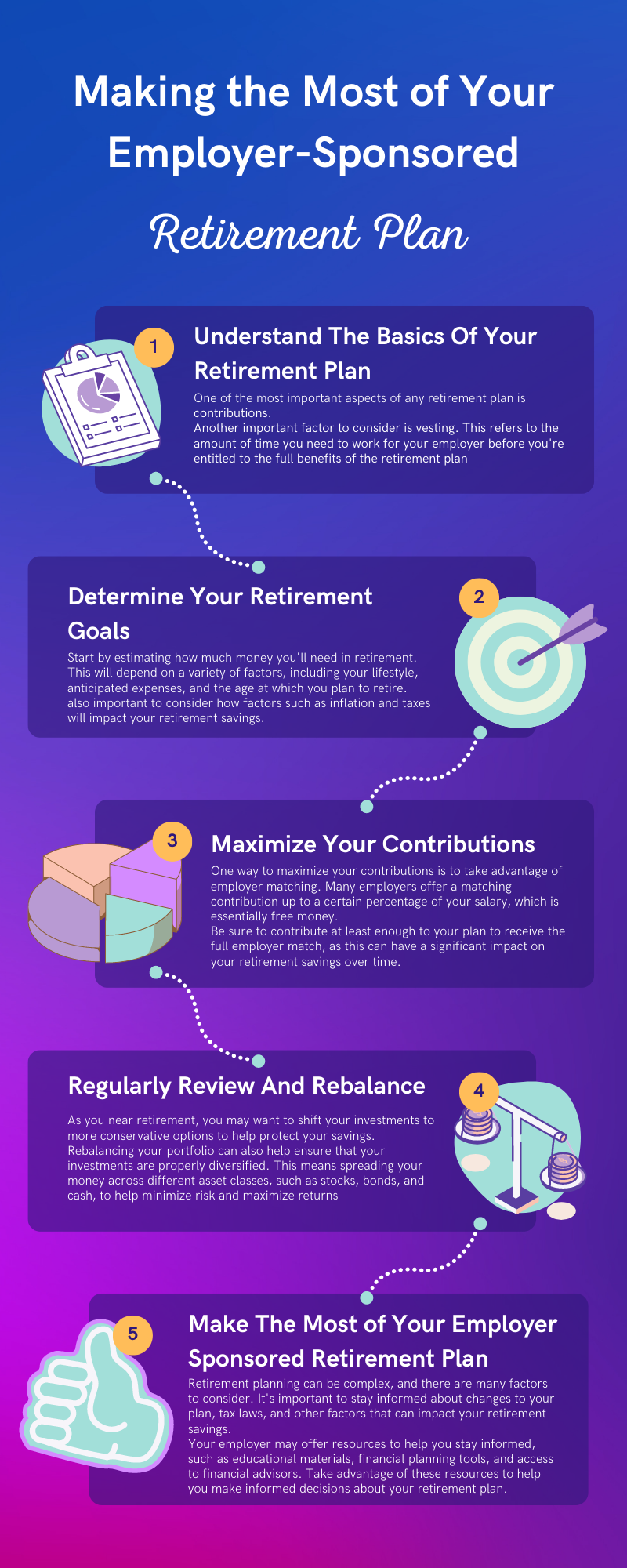Are you taking full advantage of your employer-sponsored retirement plan? If not, you could be missing out on one of the most powerful tools for building a secure retirement.
These plans are designed to help you save for your golden years, and they offer a range of benefits that can help you achieve your financial goals.
But navigating the world of retirement plans can be overwhelming, and it’s not always easy to know where to start. That’s why I’ve put together this guide to help you make the most of your employer-sponsored retirement plan.
Whether you’re just getting started with saving for retirement or you’re a seasoned pro, this guide has something for everyone.
I’ll cover everything you need to know about employer-sponsored retirement plans, from the basics of how they work to the importance of maximizing your contributions and taking advantage of employer matching.
I’ll also discuss the different investment options available, as well as the importance of revisiting and adjusting your plan regularly to ensure you stay on track.
By the end of this guide, you’ll have a better understanding of how your employer-sponsored retirement plan works, and you’ll be equipped with the knowledge and tools you need to start building a more secure financial future.
So let’s dive in and start making the most of your retirement plan!

Understand The Basics Of Your Retirement Plan
The first step to making the most of your employer-sponsored retirement plan is to understand the basics of how the plan works.
Retirement plans can be complex and confusing, but taking the time to learn about the key components of your plan can help you make better decisions and achieve your retirement goals.
One of the most important aspects of any retirement plan is contributions. This refers to the amount of money that you and your employer contribute to your retirement account.
It’s essential to understand how much you’re contributing and how much your employer is contributing on your behalf, as this will have a significant impact on the size of your retirement nest egg.
Another important factor to consider is vesting. This refers to the amount of time you need to work for your employer before you’re entitled to the full benefits of the retirement plan. Some plans have immediate vesting, while others have a vesting schedule that gradually increases over time.
Finally, it’s crucial to understand the investment options available within your retirement plan. This includes the types of funds and the level of risk associated with each investment.
It’s important to choose investments that align with your goals and risk tolerance, as this can have a significant impact on your retirement savings over time.
In short, understanding the basics of your retirement plan is a critical first step in making the most of this valuable benefit. By taking the time to learn about the different components of your plan, you can make more informed decisions and take control of your financial future.
Determine Your Retirement Goals
The second point to making the most of your employer-sponsored retirement plan is to determine your retirement goals. Having a clear idea of what you want to achieve in retirement is crucial to creating a plan that will get you there.
Start by estimating how much money you’ll need in retirement. This will depend on a variety of factors, including your lifestyle, anticipated expenses, and the age at which you plan to retire.
Once you have an estimate of how much you’ll need, you can work backwards to determine how much you need to save each year to reach your goal.
It’s also important to consider how factors such as inflation and taxes will impact your retirement savings. Inflation can erode the value of your savings over time, while taxes can eat into your retirement income. Understanding these factors can help you make more informed decisions about how to save and invest for retirement.
Finally, it’s important to be realistic about your retirement goals. While it’s important to have big aspirations, you’ll also need to make trade-offs and sacrifices along the way. This might mean cutting back on expenses now, so you can save more for retirement, or delaying retirement to give yourself more time to build your nest egg.
In short, determining your retirement goals is an important step in making the most of your employer-sponsored retirement plan. By having a clear idea of what you want to achieve and what it will take to get there, you can create a plan that will help you build a secure and fulfilling retirement.
Maximize Your Contributions
The third point to making the most of your employer-sponsored retirement plan is to maximize your contributions. While there are limits to how much you can contribute to your plan each year, it’s important to contribute as much as you can afford.
One way to maximize your contributions is to take advantage of employer matching. Many employers offer a matching contribution up to a certain percentage of your salary, which is essentially free money.
Be sure to contribute at least enough to your plan to receive the full employer match, as this can have a significant impact on your retirement savings over time.
Another way to maximize your contributions is to take advantage of catch-up contributions.
If you’re age 50 or older, you’re eligible to make additional contributions to your retirement plan each year. This can be particularly helpful if you’re behind on your savings goals and need to catch up.
It’s also important to consider the tax benefits of contributing to your retirement plan. Contributions to a traditional 401(k) plan are made on a pre-tax basis, which means you’ll pay less in taxes now but will pay taxes on your withdrawals in retirement.
Contributions to a Roth 401(k) plan, on the other hand, are made on an after-tax basis, but withdrawals in retirement are tax-free.
Maximizing your contributions is an important step in making the most of your employer-sponsored retirement plan. By taking advantage of employer matching, catch-up contributions, and the tax benefits of your plan, you can build a more secure retirement and achieve your financial goals.
Regularly Review And Rebalance
The fourth point to making the most of your employer-sponsored retirement plan is to regularly review and rebalance your investments. It’s important to periodically review your investment choices to ensure they continue to align with your goals and risk tolerance.
As you near retirement, you may want to shift your investments to more conservative options to help protect your savings.
On the other hand, if you’re early in your career, you may want to take on more risk to potentially earn higher returns.
Rebalancing your portfolio can also help ensure that your investments are properly diversified. This means spreading your money across different asset classes, such as stocks, bonds, and cash, to help minimize risk and maximize returns.
By rebalancing your portfolio, you can ensure that you’re not too heavily invested in one particular area, which can help protect your savings in the event of market fluctuations.
In addition to reviewing and rebalancing your investments, it’s also important to keep an eye on fees. Every retirement plan has fees associated with it, such as administrative fees and investment management fees.
These fees can eat into your savings over time, so it’s important to understand what you’re paying and whether there are ways to reduce these costs.
Regularly reviewing and rebalancing your investments is an important step in making the most of your employer-sponsored retirement plan.
By ensuring that your investments align with your goals and risk tolerance, and keeping an eye on fees, you can build a more secure retirement and achieve your financial goals.
Make The Most Of Your Employer Sponsored Retirement Plan
The fifth and final point to making the most of your employer-sponsored retirement plan is to stay informed and seek help when needed.
Retirement planning can be complex, and there are many factors to consider. It’s important to stay informed about changes to your plan, tax laws, and other factors that can impact your retirement savings.
Your employer may offer resources to help you stay informed, such as educational materials, financial planning tools, and access to financial advisors. Take advantage of these resources to help you make informed decisions about your retirement plan.
If you’re unsure about how to proceed or need help with your retirement planning, don’t be afraid to seek help. You can consult with a financial advisor, who can help you develop a personalized retirement plan that takes into account your unique circumstances and goals.
Finally, it’s important to be patient and stay committed to your retirement plan. Building a secure retirement takes time and discipline, but the rewards are well worth it.
By staying informed, seeking help when needed, and staying committed to your retirement plan, you can build a secure and fulfilling retirement.
Making the most of your employer-sponsored retirement plan requires a combination of careful planning, consistent saving, and smart investing.
By following these five points – determining your retirement goals, maximizing your contributions, reviewing and rebalancing your investments, staying informed, and seeking help when needed – you can build a more secure and fulfilling retirement.





